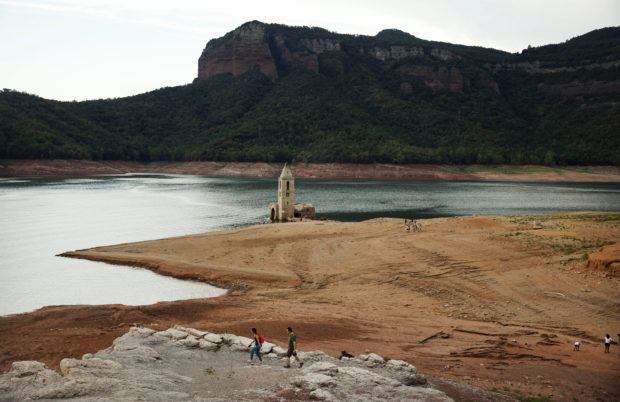
People walk arround the remains of the church of Sant Roma de Sau as it emerges from the low waters of the Sau Reservoir, north of Barcelona, Spain, August 8, 2022. A prolonged dry spell and extreme heat that made last July the hottest month in Spain since at least 1961, have left Spanish reservoirs at just 40% of capacity on average in early August, well below the ten-year average of around 60%, official data shows.REUTERS
CIJARA, Spain — A flock of sheep shelter from the midday sun under the gothic arches of a medieval bridge flooded in 1956 to create the Cijara reservoir in central Spain, but now fully exposed as the reservoir is 84% empty after a severe drought.
In Andalusia, one of Europe’s hottest and driest regions, paddle-boats and waterslides lie abandoned on the cracked bed of Vinuela reservoir, remnants of a rental business gone with the water, now at a critical level of 13%.
A nearby restaurant fears a similar fate.
“The situation is quite dramatic in the sense that it’s been several years without rain and we’re hitting rock bottom,” said owner Francisco Bazaga, 52. “If it doesn’t rain, unless they find some alternative water supply, the future is very, very dark.”
The remains of the Royal Site of La Isabela bathhouse emerge from the low waters of the Buendia reservoir, in Sacedon, Spain, August 7, 2022. A prolonged dry spell and extreme heat that made last July the hottest month in Spain since at least 1961, have left Spanish reservoirs at just 40% of capacity on average in early August, well below the ten-year average of around 60%, official data shows. REUTERS
A prolonged dry spell and extreme heat made July the hottest month in Spain since at least 1961. Spanish reservoirs are at just 40% of capacity on average in early August, well below the ten-year average of around 60%, official data shows.
“We are in a particularly dry year, a very difficult year that confirms what climate change scenarios have been highlighting,” Energy Minister Teresa Ribera told a news conference on Monday, also highlighting that the drought was leading to devastating wildfires.
Climate change has left parts of the Iberian peninsula at their driest in 1,200 years, and winter rains are expected to diminish further, a study published last month by the Nature Geoscience journal showed.
A sheep drinks water from the dried bed of the Guadiana river during a severe drought in the Cijara reservoir, in Villarta de los Montes, Spain, August 6, 2022. A prolonged dry spell and extreme heat that made last July the hottest month in Spain since at least 1961, have left Spanish reservoirs at just 40% of capacity on average in early August, well below the ten-year average of around 60%, official data shows.REUTERS
The dry, hot weather is likely to continue into the autumn, Spain’s meteorological service AEMET said in a recent report, putting further strain on Europe’s largest network of dammed reservoirs with a holding capacity of 5.6 billion cubic meters.
At the Buendia reservoir east of Madrid, the ruins of a village and bathhouses have reappeared, caked in dried mud, Reuters drone footage showed, while at another dam near Barcelona a ninth-century Romanesque church has reemerged still intact, attracting visitors.
RELATED STORIES
Spain sounds high alert for scorching heatwave
Western Europe wilts under second heatwave in weeks
Firefighters scramble to put out flames in heatwave-hit Portugal, Spain
Heatwave grips Spain as UK readies for soaring temperatures